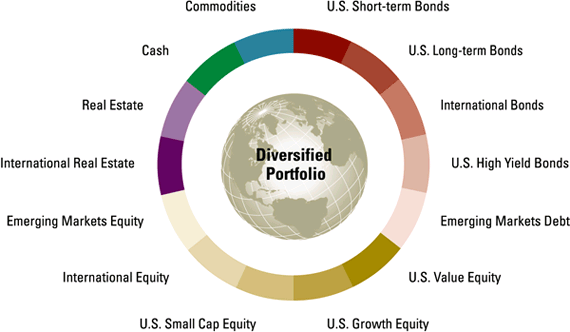An investment portfolio is a basket of various types of financial assets owned by an investor.
These assets can be in the form of equities (stocks), fixed income (bonds), mutual funds, exchange-traded funds (ETFs), real estate, commodities, and more. It’s a tool to manage and diversify risk while seeking returns.
The art of investment revolves around the strategic assembly of financial assets into an investment portfolio. The portfolio you build is more than just a collection of assets; it’s a tangible reflection of your financial goals, risk tolerance, and investment horizon.
The Concept of Risk and Return

Source: SDATT
Risk and return are two fundamental elements of investing. Higher potential returns are often associated with a higher level of risk. Therefore, the process of portfolio management involves balancing these two factors based on an investor’s financial goals and risk tolerance.
A prime example of risk diversification would be the portfolio of legendary investor Warren Buffett’s company, Berkshire Hathaway, which spans sectors from insurance and utilities to food and clothing, effectively distributing risk.
Factors Influencing Portfolio Construction
Creating an investment portfolio is a personalized process, shaped by several key factors:
-
Financial Goals: The primary driver of portfolio construction is the financial goal of the investor. For example, the portfolio of a young professional saving for retirement will look vastly different from that of a retiree seeking regular income.
-
Risk Tolerance: This determines the level of risk an investor is willing to take. A tech entrepreneur may be comfortable with high-risk growth stocks like Tesla, while a pension fund might prefer the steady income of blue-chip dividends.
-
Investment Horizon: The length of time the investor plans to invest will influence the asset mix. Long-term investors can afford to take more risks as they have more time to recover from potential losses.
-
Income, Savings, and Liquidity Needs: Investors with high income and savings can typically afford to take on more risk. Similarly, liquidity needs can affect portfolio construction. If you need to have ready access to cash, you’ll want more liquid investments in your portfolio.
-
Market Conditions: Prevailing market conditions can also impact portfolio construction. During a recession, investors might prioritize defensive sectors like utilities or consumer staples.
The Building Blocks of an Investment Portfolio
The careful selection and combination of asset classes lay the foundation of an investment portfolio.
Asset Allocation
This involves dividing an investment portfolio among different asset categories, such as equities, bonds, and cash. The process is typically done in three ways:
-
Strategic Asset Allocation: This strategy involves setting target allocations for various asset classes and rebalancing the portfolio periodically back to these targets. This strategy was employed by Yale Endowment, which helped them achieve superior returns over decades.
-
Tactical Asset Allocation: This is a more active strategy that tries to position a portfolio into those assets, sectors, or individual stocks that show the most potential for perceived gains.
-
Constant-Weighting Asset Allocation: In this strategy, the portfolio is rebalanced to the original weights when they deviate by a predetermined amount.
Sector and Geographical Diversification

Source: Gold IRA Guide
Diversification across sectors and geographical regions further mitigates risk. For instance, the 2008 recession hit financial companies hard, but technology companies like Apple and Amazon weathered the storm relatively well.
Portfolio Management Strategies
There are several strategies to manage a portfolio:
-
Passive Investment Strategy: This strategy attempts to maximize returns over the long run by keeping the amount of buying and selling to a minimum. A classic example is investing in an S&P 500 index fund.
-
Active Investment Strategy: This strategy requires a hands-on approach where managers make specific investments with the goal of outperforming an investment benchmark index. Hedge funds are a classic example of active management.
-
Hybrid Strategy: A combination of active and passive strategies. A notable proponent of this approach is Ray Dalio’s Bridgewater Associates.
Measuring Portfolio Performance
Portfolio performance is measured using various metrics:
-
Benchmarking: This involves comparing a portfolio’s returns to a relevant benchmark, such as the S&P 500 for a portfolio of US stocks.
-
Performance Metrics: Various ratios like the Sharpe ratio, Sortino ratio, Alpha, and Beta are used to measure the risk-adjusted returns, the performance relative to the market, and the sensitivity of the portfolio to the market, respectively.
Regular portfolio reviews help in aligning the investment strategy with the investor’s goals. The financial crisis of 2008 serves as a reminder of the importance of regular reviews, as many investors found their portfolios overexposed to risky assets.
The Role of Professional Guidance
Professional financial advisors can add value by helping to define investment goals, constructing and managing the portfolio, and providing tax-efficient strategies. Similarly, robo-advisors, digital platforms that provide automated, algorithm-driven financial planning services, are a modern, cost-effective solution for portfolio management.
Conclusion
An investment portfolio is a dynamic, personalized tool that changes with your financial goals, market conditions, and personal circumstances. By understanding its intricacies, you can better align it to your financial vision and optimize returns. Regular reviews, informed decisions, and professional guidance are the cornerstones of successful portfolio management.
- SEO Powered Content & PR Distribution. Get Amplified Today.
- PlatoData.Network Vertical Generative Ai. Empower Yourself. Access Here.
- PlatoAiStream. Web3 Intelligence. Knowledge Amplified. Access Here.
- PlatoESG. Automotive / EVs, Carbon, CleanTech, Energy, Environment, Solar, Waste Management. Access Here.
- PlatoHealth. Biotech and Clinical Trials Intelligence. Access Here.
- ChartPrime. Elevate your Trading Game with ChartPrime. Access Here.
- BlockOffsets. Modernizing Environmental Offset Ownership. Access Here.
- Source: https://www.peakframeworks.com/post/investment-portfolios



